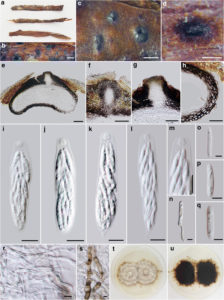Ditopella aseptatospora Qing Tian, Camporesi & K.D. Hyde, sp. nov., MycoBank number: MB 820841
Saprobic on dead branch of Alnus glutinosa (Betulaceae). Sexual morph Ascomata(370–)460–600 μm high × 130–300 (−380) μm diam. (x̅ = 526 × 243 μm, n = 10), perithecial, solitary, immersed below the host epidermis, erumpent to nearly superficial, broadly conical to globose, black, membranous, smooth, ostiolate. Ostiole single, central, flattened, with a short neck, with periphyses. Wall of ascomata (35–)45–58(−65) μm (x̅ = 52 μm, n = 20) wide, thicker at apex, 2-layered, externally comprising pigmented, dark brown, thick-walled cells of textura angularis, with inner layer thinner, composed of irregularly shaped lightly pigmented to hyaline, thin-walled cells of textura prismatica. Hamathecium lacking paraphyses. Asci 65–85 × 12–17 μm (x̅ = 76.7 × 15.3 μm, n = 10), 32-spored, unitunicate, cylindrical to clavate, straight or slightly curved, with a short pedicel or apedicellate, with a refractive apical ring. Ascospores 13–18(−19) × 2.5–4 μm (x̅ = 16.3 × 3.4 μm, n = 10), multiseriate, cylindrical to oblong, hyaline, rounded at both ends, straight or slightly curved, aseptate, guttulate, smooth and thick-walled, lacking a gelatinous sheath or appendages. Asexual morph Undetermined.
Culture characteristics: Colonies on MEA, reaching 35–40 mm diam. after 21 d at 25 °C, circular, dense, felty, zonate, pale brown towards edges, flattened, with aerial mycelium on the surface, irregular at margin, reverse brown.
Material examined: ITALY, Province of Forlì-Cesena [FC], near San Benedetto in Alpe, on dead branch of Alnus glutinosa (Betulaceae), 18 April 2016, Erio Camporesi, IT-2942 (MFLU 16–1294, holotype), living culture, MFLUCC 17–0243, KUMCC 16–0193. ibid. (KUN! HKAS 96225, isotype).
Notes: Phylogenetically, this collection resides in a clade of Ditopella and is closely related to D. ditopa(Fig. 8; 100% ML, 99% MP, 1.00 PP). Our isolate is morphologically similar to D. ditopa (strain LCM 94.02), but D. aseptatospora has thinner, cylindrical asci and aseptate, guttulate ascospores versus wider, elongate-ellipsoidal to sac-like asci and 1-septate ascospores in D. ditopa. Ditopella biseptata and D. cryptosphaeria are species found on Alnus glutinosa. Morphologically, D. biseptata has (1)2(−3)-septate ascospores with minute appendages at both ends, D. cryptosphaeria has somewhat larger asci on average (100 × 15–17, Saccardo 1882) and fusoid to oblong ascospores; thus, we introduced D. aseptatospora as a new species.
Fig. Ditopella aseptatospora (holotype). a Herbarium specimen. b–d Appearance of ascomata on the host branch. e Vertical section through ascoma. f–h Vertical section through peridium, note the ostiole. i–l Asci with ascospores. m Unitunicate ascus, note the apical ring. n Germinating ascospore on MEA after 12 h. o–q Ascospores. r, sVegetative hyphae from cultures. t, u Cultures on MEA. Scale bars: b = 500 μm, c, d = 200 μm, e = 100 μm, f–h = 50 μm, i–m = 10 μm, n–s = 5 μm.

